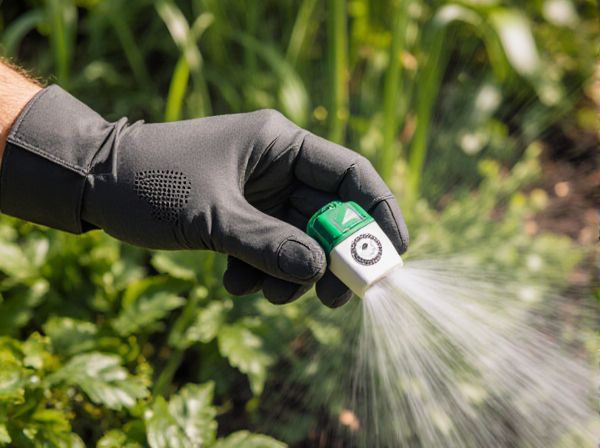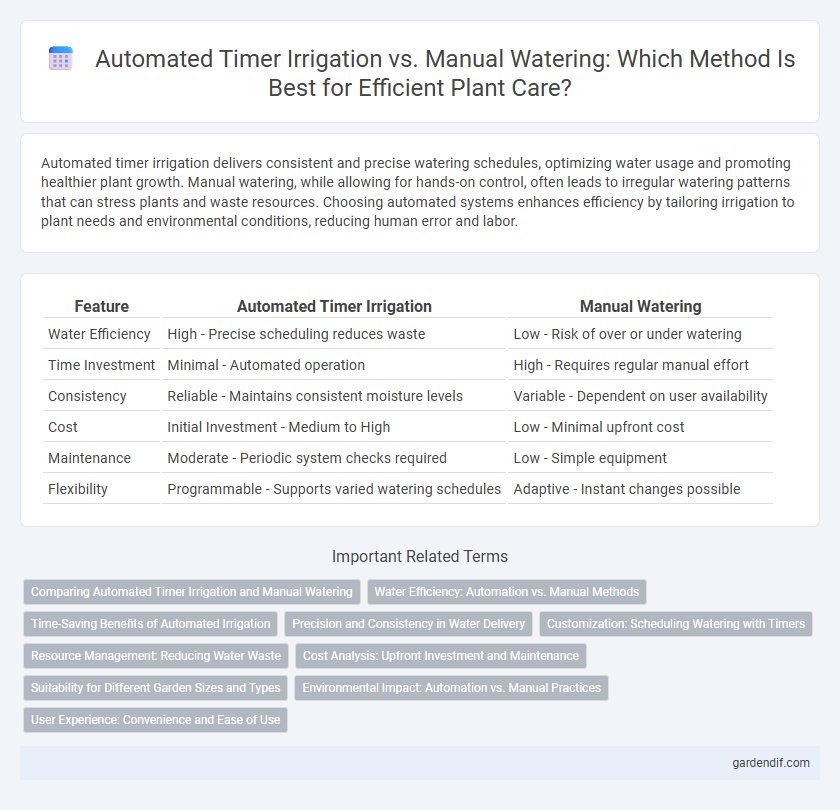
Automated timer irrigation vs Manual watering Illustration
Automated timer irrigation delivers consistent and precise watering schedules, optimizing water usage and promoting healthier plant growth. Manual watering, while allowing for hands-on control, often leads to irregular watering patterns that can stress plants and waste resources. Choosing automated systems enhances efficiency by tailoring irrigation to plant needs and environmental conditions, reducing human error and labor.
Table of Comparison
| Feature | Automated Timer Irrigation | Manual Watering |
|---|---|---|
| Water Efficiency | High - Precise scheduling reduces waste | Low - Risk of over or under watering |
| Time Investment | Minimal - Automated operation | High - Requires regular manual effort |
| Consistency | Reliable - Maintains consistent moisture levels | Variable - Dependent on user availability |
| Cost | Initial Investment - Medium to High | Low - Minimal upfront cost |
| Maintenance | Moderate - Periodic system checks required | Low - Simple equipment |
| Flexibility | Programmable - Supports varied watering schedules | Adaptive - Instant changes possible |
Comparing Automated Timer Irrigation and Manual Watering
Automated timer irrigation systems deliver precise water amounts at scheduled intervals, optimizing water use efficiency and promoting healthier plant growth. Manual watering relies heavily on user attention and consistency, often leading to overwatering or underwatering and inefficient resource usage. Studies indicate that automated systems can reduce water consumption by up to 30% compared to manual methods, improving sustainability in irrigation practices.
Water Efficiency: Automation vs. Manual Methods
Automated timer irrigation systems deliver precise water amounts at scheduled intervals, reducing waste and enhancing water efficiency by targeting root zones consistently. Manual watering often results in overwatering or underwatering due to human error, leading to inefficient water use and potential plant stress. Studies indicate automated systems can save up to 30% more water compared to manual methods, optimizing irrigation for environmental sustainability.
Time-Saving Benefits of Automated Irrigation
Automated timer irrigation systems significantly reduce the time spent on watering by precisely controlling irrigation schedules without constant human intervention. These systems allow for efficient water management, delivering optimal moisture levels at set intervals to promote healthy plant growth while freeing up valuable time for other tasks. Manual watering demands regular attention and effort, making automated solutions a superior choice for time-saving in both residential and commercial landscapes.
Precision and Consistency in Water Delivery
Automated timer irrigation systems deliver precise amounts of water at scheduled intervals, ensuring consistent moisture levels for optimal plant growth. Manual watering often varies in timing and volume, leading to irregular water delivery and potential over- or under-watering. Precision in automated irrigation reduces water waste and promotes healthier plants by maintaining consistent soil hydration.
Customization: Scheduling Watering with Timers
Automated timer irrigation systems offer precise customization by allowing users to schedule watering based on specific time intervals and plant needs, ensuring optimal water usage. Manual watering lacks this consistency, often leading to under- or over-watering due to irregular schedules. Timed irrigation optimizes resource efficiency and promotes healthier plant growth by adapting watering routines to environmental conditions and seasonal changes.
Resource Management: Reducing Water Waste
Automated timer irrigation systems optimize resource management by precisely scheduling watering times based on soil moisture levels and weather data, significantly reducing water waste compared to manual watering methods. These systems prevent overwatering and runoff by delivering exact water quantities tailored to plant needs, enhancing overall water use efficiency. Manual watering often leads to inconsistent application, increasing the risk of water wastage and inefficient resource utilization.
Cost Analysis: Upfront Investment and Maintenance
Automated timer irrigation systems require a higher upfront investment due to the cost of timers, sensors, and installation, while manual watering primarily incurs minimal initial expense for basic equipment such as hoses and sprinklers. Maintenance costs for automated systems can include sensor calibration, timer programming, and occasional repairs, whereas manual watering requires less frequent maintenance but involves higher ongoing labor costs. Over time, automated irrigation often leads to water savings and reduced labor expenses, which can offset initial setup and maintenance investments.
Suitability for Different Garden Sizes and Types
Automated timer irrigation systems offer precise water delivery, making them ideal for large gardens and complex landscaping with varying plant needs, ensuring consistent moisture levels. Manual watering suits smaller gardens or areas with diverse plant types, providing flexibility to adjust watering based on real-time observation and specific plant health. Gardeners should consider garden size, plant variety, and labor availability when selecting between automated timers and manual watering for optimal irrigation efficiency.
Environmental Impact: Automation vs. Manual Practices
Automated timer irrigation systems optimize water usage by delivering precise amounts at scheduled intervals, significantly reducing water waste and runoff compared to manual watering. Manual watering often leads to overwatering or underwatering due to inconsistent timing and human error, which can negatively impact soil health and increase water consumption. By integrating sensors and automated controls, timer irrigation enhances water conservation and supports sustainable environmental practices.
User Experience: Convenience and Ease of Use
Automated timer irrigation systems offer unparalleled convenience by scheduling watering cycles without manual intervention, allowing users to save time and reduce effort in garden maintenance. These systems ensure consistent water distribution, minimizing human error and optimizing plant health through precise timing and duration settings. In contrast, manual watering requires constant attention and physical effort, often leading to inconsistent irrigation and increased user burden, especially in larger gardens.
Automated timer irrigation vs Manual watering Infographic

 gardendif.com
gardendif.com